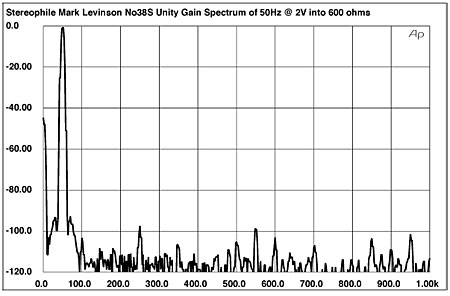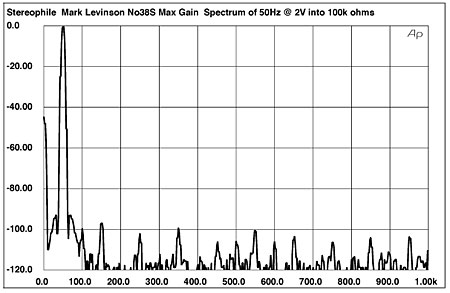| Columns Retired Columns & Blogs |
Mark Levinson No.38S preamplifier Measurements
Sidebar 3: Measurements
In Robert Harley's original review of the Levinson No.38, he commented that he found its technical performance "extraordinary." I found the same to be true of the No.38S. Its frequency response was flat within the audioband, 0.1dB down at 50kHz, which is a little better than the No.38, which was –0.4dB at this frequency. Crosstalk was lower than –106dB at all frequencies below 18kHz, this measured with the undriven input loaded by the source impedance of the Audio Precision generator. This is the best channel-separation I've seen in a preamp. The Levinson's output polarity was non-inverting, with the XLR jacks wired with pin 2 as positive, or "hot."
Conventional preamplifier volume controls immediately follow the source-selector switch and input jacks—a topology that effectively renders them "bombproof" regarding overload. The No.38S's use of an active volume control, however, means that there will be a finite input voltage limit. I found this to be above the range of source-component output levels at 16V balanced and 8V unbalanced.
The '38S's measured output impedance was identical to that of the '38, at 6.4 ohms at 1kHz from the unbalanced jacks, this rising by a fraction of an ohm at the band edges. From the balanced outputs, it doubled as expected (there are now two output amplifiers in series). The volume control gave unity gain at an indicated setting of "73.1dB"; set to its maximum "92dB" setting, the measured voltage gain in balanced mode was 18.9dB. In connection with another project, Tom Norton painstakingly checked the preamp's volume-control accuracy between the 40dB and 92dB settings: the output level and channel balance generally matched the control setting to within 0.01dB, with the maximum error just 0.05dB—which is extraordinary considering the preamp's stereo volume control has four sections.
Set to unity gain and operated balanced, the No.38S's steady-state linearity was both superb and better than the plain No.38. At a 2V output level, it measured at the 0.001% level into 100k ohms below 10kHz (fig.1), this rising slightly above that frequency as well as into a lower load (600 ohms). With the active gain-stage engaged and at a high 10V output level, the measured level of distortion into 100k ohms actually dropped slightly. Into lower loads, however, it rose, but to still insignificant levels. Fig.2, for example, shows that, at 10V into 600 ohms (balanced), the THD+noise reading was about 0.012% across the band. (The analyzer bandwidth was set to 500kHz for this measurement to capture the full contribution of the upper harmonics, compared to 80kHz for fig.1, which doubles the instrument's sensitivity. All other things being equal, increasing the Audio Precision's measurement bandwidth increases the '38S's measured THD+N level at 1kHz from 0.00108% to 0.00247%.)

Fig.1 Mark Levinson No.38S, THD+noise (%) vs frequency at 2V output level with volume control set to #73.1 in balanced mode (from top to bottom): into 600 ohms; into 100k ohms (right channel dashed).

Fig.2 Mark Levinson No.38S, THD+noise (%) vs frequency at 10V output level with volume control set to #92 in balanced mode (from top to bottom): into 600 ohms; into 100k ohms (right channel dashed).
The spectrum of the No.38S's distortion harmonics depended somewhat on the level and the load; it was not affected by whether the gain stage was in circuit or not. Fig.3, for example, shows the No.38S's output spectrum reproducing a 50Hz sinewave at 2V into 100k ohms while set to unity gain. The highest harmonics are the third at 150Hz (–98dB), the fifth at 250Hz (–99dB), and the eleventh at 550Hz (–98dB)—though I'm suspicious that the latter might be a measurement artifact. Dropping the load to 600 ohms (fig.4) dropped the third harmonic into the noise floor, while setting the volume control to its maximum and readjusting the input to give a 2V output level produced a spectrum (fig.5) not significantly different from the unity-gain situation (fig.3).

Fig.3 Mark Levinson No.38S, spectrum of 50Hz sinewave, DC–1kHz, at 2V into 100k ohms with volume control set for unity gain in balanced mode (linear frequency scale). Note that the third harmonic at 150Hz is the highest in level, 98dB below the level of the 50Hz fundamental (0.0013%).

Fig.4 Mark Levinson No.38S, spectrum of 50Hz sinewave, DC–1kHz, at 2V into 600 ohms with volume control set for unity gain in balanced mode (linear frequency scale). Note that the fifth harmonic at 250Hz is the highest in level, 97dB below the level of the 50Hz fundamental (0.0014%).

Fig.5 Mark Levinson No.38S, spectrum of 50Hz sinewave, DC–1kHz, at 2V into 100k ohms with volume control set to #92 in balanced mode (linear frequency scale). Note that the third harmonic at 150Hz is the highest in level, 97dB below the level of the 50Hz fundamental (0.0014%).
Finally, the No.38S's output stage clipped (1% THD+N) at around 17V into 100k ohms, 16V into 600 ohms. This can be seen in the graph of output voltage plotted against distortion percentage into the two loads with the volume control set to its maximum (fig.6). Note that, below 2V output into either load, the measured distortion is dominated by noise, this indicated by the fact that the THD figure drops with increasing level. (The noise level remains the same but the signal gets larger, meaning that the noise becomes a lower percentage of that signal.) Into 100k with the volume control wide open, the lowest measured THD+N level is reached at 10V output—an input of around 1V. Into the low impedance, however, the distortion starts to rise above the noise above 2V, though as fig.2 suggested, it still doesn't reach significant levels.

Fig.6 Mark Levinson No.38S, distortion (%) vs output voltage in balanced mode (from bottom to top at 10V): into 100k ohms; into 600 ohms.
These measurements suggest that the No.38S is a superb piece of audio engineering design.—John Atkinson
- Log in or register to post comments




































